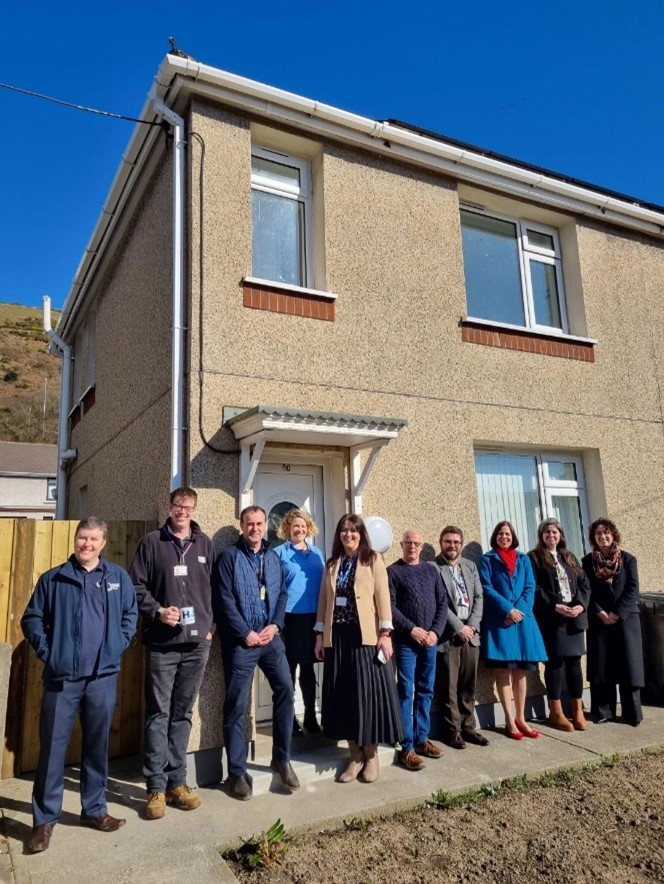Article
The 1920s semi-detached home which has been retrofitted to become a showcase house of the future.
This article is more than 6 months old
28 April 2025
In collaboration with Tai Tarian and Cardiff University’s Welsh School of Architecture (WSA), the Homes as Power Stations (HAPS) Swansea Bay City Deal (SBCD) project, led by Neath Port Talbot Council, has created the region's first ‘HAPS Retrofit Demonstration House’ on Geifr Road in Margam, Port Talbot.
This innovative project showcases advanced retrofit solutions and aims to educate a wide range of stakeholders on the installations, lessons learned, and benefits of these technologies.
The 1920s, three-bedroom, semi-detached home has been retrofitted with renewable energy supply, storage, and demand reduction solutions.
The house features:
- Increased insulation.
- Reduced air leakage.
- Improved ventilation.
- A low carbon air-source heat pump for heating and hot water, bolt-on photovoltaic (PV) solar panels for renewable energy, and
- A 5.8kWh lithium iron phosphate battery to store excess electricity generated by the PV panels. With these additions to the home, it now has an EPC rating of A.
Additionally, the house includes Welsh wool loft insulation, external wall and plinth insulation, an upgraded distribution board, radiators compatible with the air source heat pump, insulated windows and doors, sealed skirting boards, low energy LED bulbs, and wireless monitoring devices for temperature, humidity, CO2, heat output, electricity consumption, energy generation, and storage.
These features collectively reduce the home’s reliance on existing energy networks and fossil fuels, creating a more environmentally friendly and cost-effective home, with significantly lower energy bills for future residents.
Welsh wool, used for loft insulation, is a local product sourced from Welsh farms. Wales has around 10 million sheep, more than the US and Canada combined. Truewool® is 100% Welsh Wool and carries the Welsh Wool logo, guaranteeing its source. Using wool for insulation not only supports local farmers and economy, but also contributes to a healthier indoor atmosphere, as wool is free from formaldehyde and helps bind to it, reducing indoor air pollution.
Wool is a natural material that enhances the sense of well-being and is safe and pleasant for both installers and residents.
The house is designed to showcase each step of the retrofit process, highlighting the skills and technology required to achieve maximum benefits and aims to address a significant gap in information available to landlords and homeowners on decarbonising their homes.
By sharing information and lessons learned, including incidental costs, communication challenges, reluctance to adopt new methods, focus on appearance, preference for simpler options, additional energy generation, and continued monitoring, the project aims to increase the uptake of low carbon technology and retrofit homes.
The HAPS team held open house events with Tai Tarian and Cardiff University's Welsh School of Architecture to showcase the renewable technology installed in the home and explain how it works. 370 visitors from 42 separate organisations attended the open house events, ranging from industry experts to college students. The events allowed people to visit the house and see the technology first hand, understand how it works and see the benefits of having it installed.
The main aim of the open house visits was to highlight the retrofit solutions and for the attendees to visit and learn about the operation of cutting-edge technology, and in turn how these changes can significantly reduce energy costs.
Neath Port Talbot Councillor and Cabinet Member for Climate Change and Economic Growth, Jeremy Hurley said:
"I am proud to see the success of the first HAPS Retrofit Demonstration House in Port Talbot. This project demonstrates our commitment to sustainable living and showcases innovative solutions that can transform homes into energy-efficient power stations, enhancing the quality of life for residents and paving the way for a greener future. By highlighting the importance of retrofitting existing homes to reduce carbon emissions and energy costs, we hope to inspire others to adopt similar technologies."
For more information, please contact: haps@npt.gov.uk.
